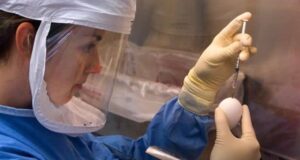
Weill Cornell Medicine researchers have determined the full-length structure of a blood pressure-regulating hormone receptor for the first time, uncovering how it functions, which may enable better drug targeting of the receptor for diseases like hypertension and heart failure.
For the study, published Nov. 14 in Nature Structural & Molecular Biology, the researchers used cryo-electron microscopy (cryo-EM), computer modeling and other advanced techniques to determine the high-resolution structure of the atrial natriuretic peptide receptor, also known as transmembrane receptor guanylyl cyclase A (GC-A).
GC-A is a type of single-pass transmembrane receptor protein that spans the cell membrane, connecting a binding region on the cell surface to an interior signaling domain, allowing it to transmit signals from outside the cell to the inside. Basically, the receptor acts as a communication channel between the cell and its environment.
These new structural details will be of interest to drug developers who want to target GC-A and related receptors to treat heart disease and other conditions.”
Dr. Xin-Yun Huang, study senior author, professor of physiology and biophysics at Weill Cornell Medicine
The study’s first author, Dr. Shian Liu, is a research associate in the department of physiology and biophysics at Weill Cornell Medicine.
Promising cardiovascular drug target
GC-A is expressed in various tissues—including the kidneys, blood vessels, adrenal glands, lungs, intestines and brain. Its partner hormones are atrial natriuretic peptides, secreted by heart cells. When the atrial natriuretic hormone binds to GC-A, the receptor is activated and sends a signal to the interior of the cell where several pathways work to lower blood pressure. This activation can also inhibit heart enlargement and other stress-related abnormalities that occur in heart disease.
GC-A’s elongated structure and relatively thin anchoring in the cell membrane make it “floppy” and difficult to capture its shape. It usually has a different conformation in each cryo-EM image. “When you try to average all these images to determine the receptor’s precise structure, you tend to end up with only a blur,” Dr. Huang said.
His team overcame this challenge through years of dedicated biochemistry and electron microscopy work and more than one billion individual images of the full-length receptor alone or bound by its partner hormone. Averaging a select set of these images and using them to develop a model of the receptor ultimately revealed the roughly mushroom-shaped structure at close to atomic-scale resolution.
The structure in focus
The researchers identified the precise arrangements and interactions of the multiple functional domains of the receptor. They also determined the points where two copies of the receptor proteins are joined, which is necessary for binding its hormone partner. This allowed them to see how the segments upon receptor activation transmit signals within the cell.
Dr. Huang and his team are now developing candidate antibody-based heart disease treatments that work by selectively binding and activating the receptor, or by making the receptor more sensitive to its partner hormones.
Other pharma companies are also developing GC-A-targeting treatments and are likely to make use of the new structural insights, Dr. Huang said.
The structure determination of GC-A provides key information about other members of the single-pass transmembrane receptor family. Researchers can use the new structural data as they attempt to develop drugs against other related receptor proteins whose structures to date have never been fully mapped. These include the growth factor receptors, whose overactivations are common features in various cancers.
“Our GC-A study should also provide a framework for thinking about the structural biochemistry of other single-pass transmembrane receptors,” Dr. Huang said.
Source:
Journal reference:
Liu, S., et al. (2024). Architecture and activation of single-pass transmembrane receptor guanylyl cyclase. Nature Structural & Molecular Biology. doi.org/10.1038/s41594-024-01426-z




